1996 CADILLAC FLEETWOOD check oil
[x] Cancel search: check oilPage 122 of 306
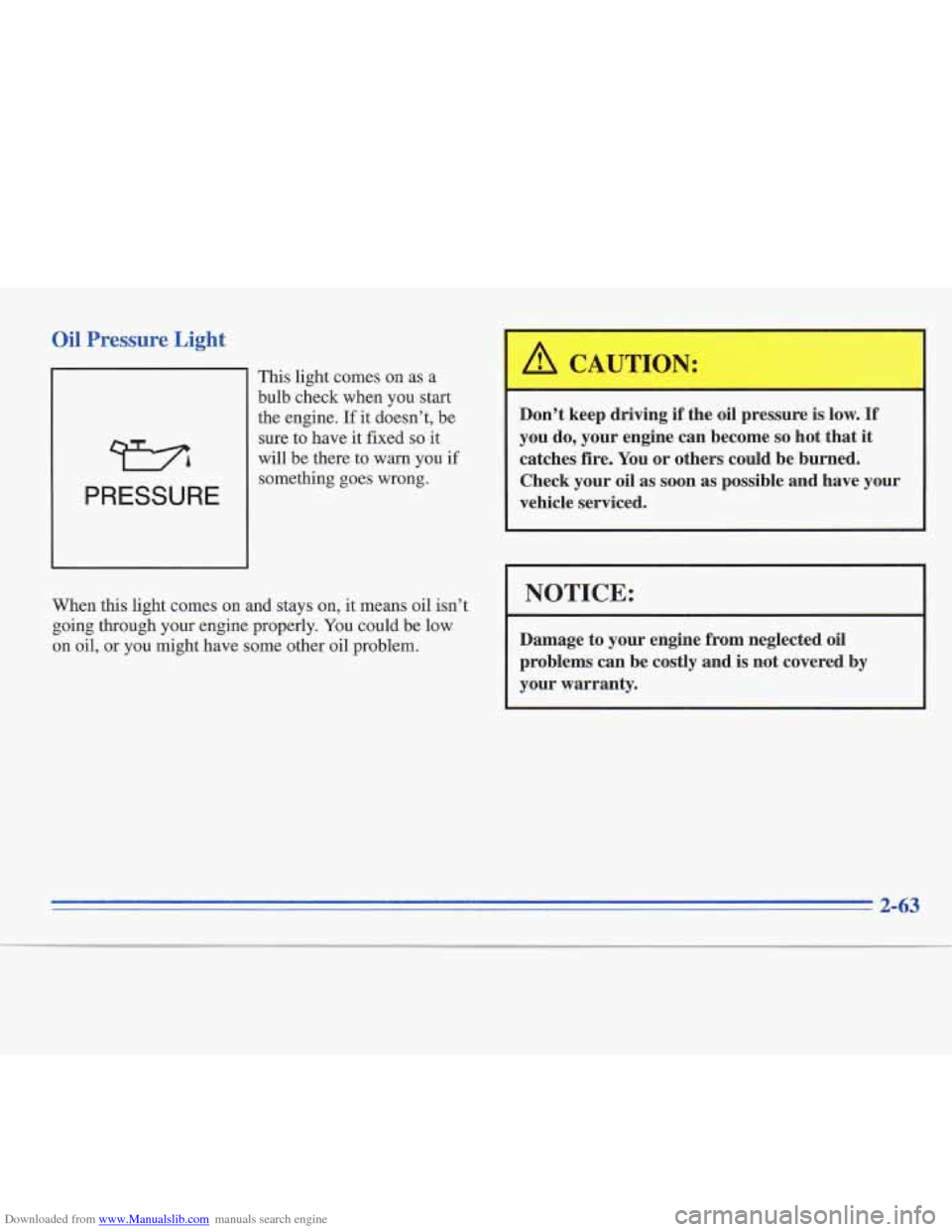
Downloaded from www.Manualslib.com manuals search engine Oil Pressure Light
WA
PRESSURE
This light comes on as a
bulb check when you start
the engine. If
it doesn’t, be
sure to have it fixed
so it
will be there
to warn you if
something goes wrong.
When
this light comes on and stays on, it means oil isn’t
going through your engine properly. You could be low
on oil, or
you might have some other oil problem.
Don’t keep driving if the oil pressure is low. If
you do, your engine can become so hot that it
catches fire. You or others could be burned.
Check your oil as
soon as possible and have your
vehicle serviced.
I NOTICE:
Damage to your engine from neglected oil
problems can be costly and
is not covered by
your warranty.
2-63
Page 123 of 306
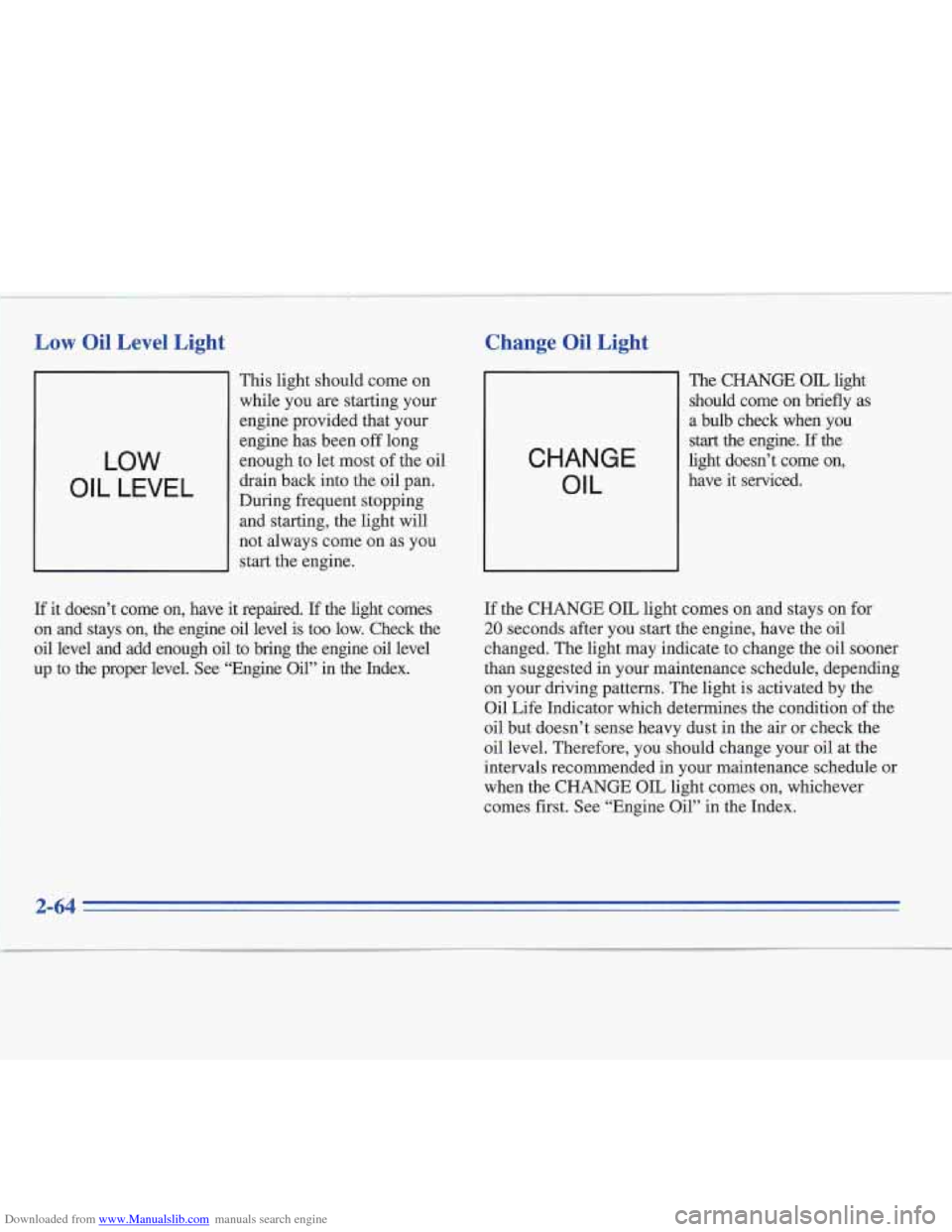
Downloaded from www.Manualslib.com manuals search engine Low Oil Level Light
11 This light should come on
while you are starting your
engine provided that your
LOW
OIL LEVEL
engine has been off long
enough to let most
of the oil
drain back into the oil pan.
During frequent stopping and starting, the light will
not always come on as you
start the engine.
If it doesn’t come on, have it repaired. If the light comes
on and stays on, the engine oil level is too low. Check the
oil level and add enough oil to bring the engine oil level
up to the proper level.
See “Engine Oil” in the Index.
Change Oil Light t
CHANGE OIL
The CHANGE OIL light
should come on briefly as
a bulb check when you
start the engine. If the
light doesn’t come on,
have it serviced.
If the CHANGE OIL light comes on and stays on for
20 seconds after you start the engine, have the oil
changed. The light may indicate to change the oil sooner
than suggested in your maintenance schedule, depending
on your driving patterns. The light is activated by the
Oil Life Inlcator which determines the condition of the
oil but doesn’t sense heavy dust in the air or check the
oil level. Therefore, you should change your oil at the
intervals recommended in your maintenance schedule or
when the CHANGE OIL light comes on, whichever
comes first. See “Engine Oil” in the Index.
Page 185 of 306
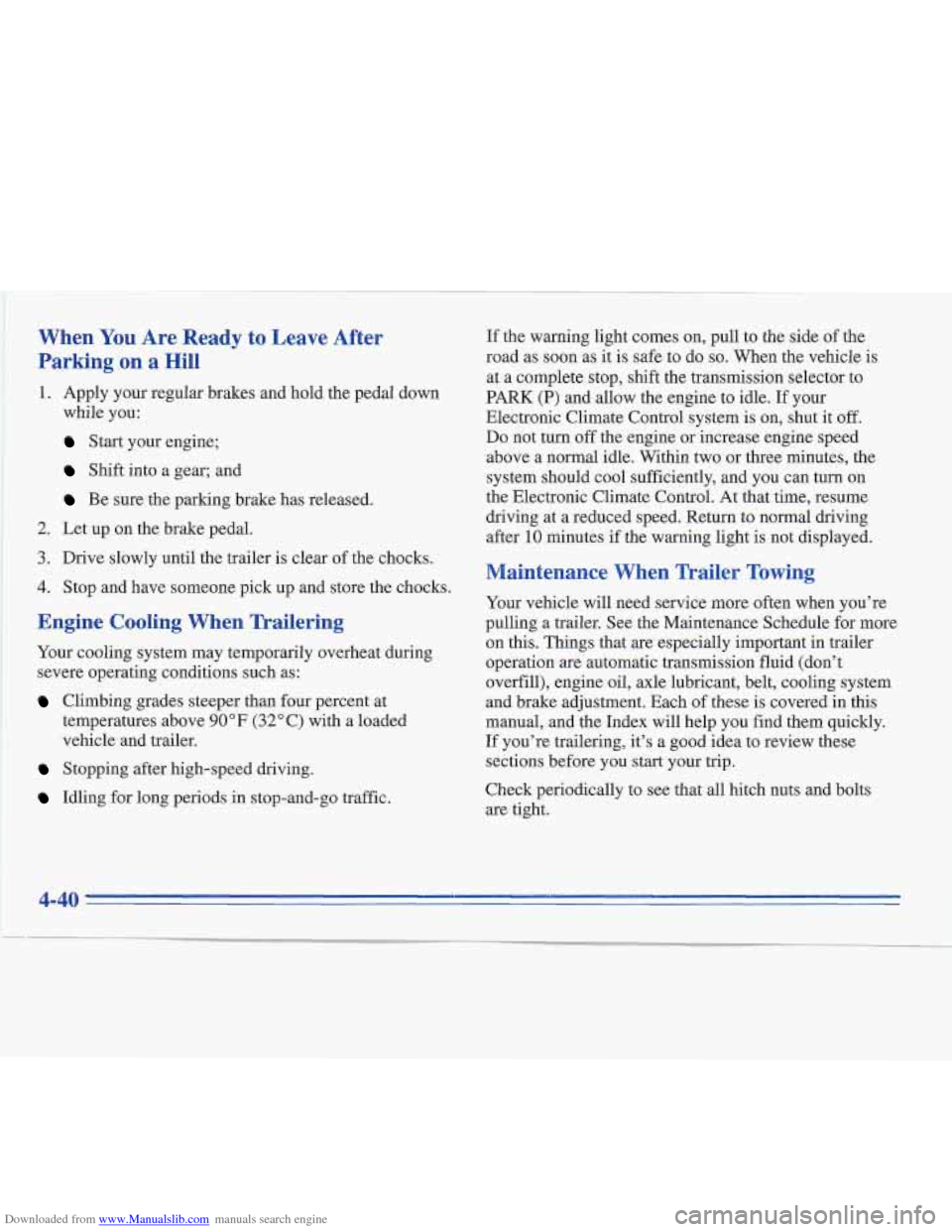
Downloaded from www.Manualslib.com manuals search engine ’men You Are Ready to Leave After
Parking on a Hill
1. Apply your regular brakes and hold the pedal down
while you:
Start your engine;
Shift into a gear; and
Be sure the parking brake has released.
2. Let up on the brake pedal.
3. Drive slowly until the trailer is clear of the chocks.
4. Stop and have someone pick up and store the chocks.
Engine Cooling When Trailering
Your cooling system may temporarily overheat during
severe operating conditions such as:
Climbing grades steeper than four percent at
temperatures above
90°F (32°C) with a loaded
vehicle and trailer.
Stopping after high-speed driving.
Idling for long periods in stop-and-go traffic.
Maintenance When Trailer Towing
Your vehicle will need service more often when you’re
pulling a trailer. See the Maintenance Schedule for more
on this. Things that
are especially important in trailer
operation are automatic transmission fluid (don’t
overfill), engine oil, axle lubricant, belt, cooling system and brake adjustment. Each of these is covered in this
manual, and the Index will help you find them quickly.
If you’re trailering, it’s a good idea to review these
sections before
you start your trip.
Check periodically to see that all hitch nuts and bolts
are tight.
4-40
Page 221 of 306
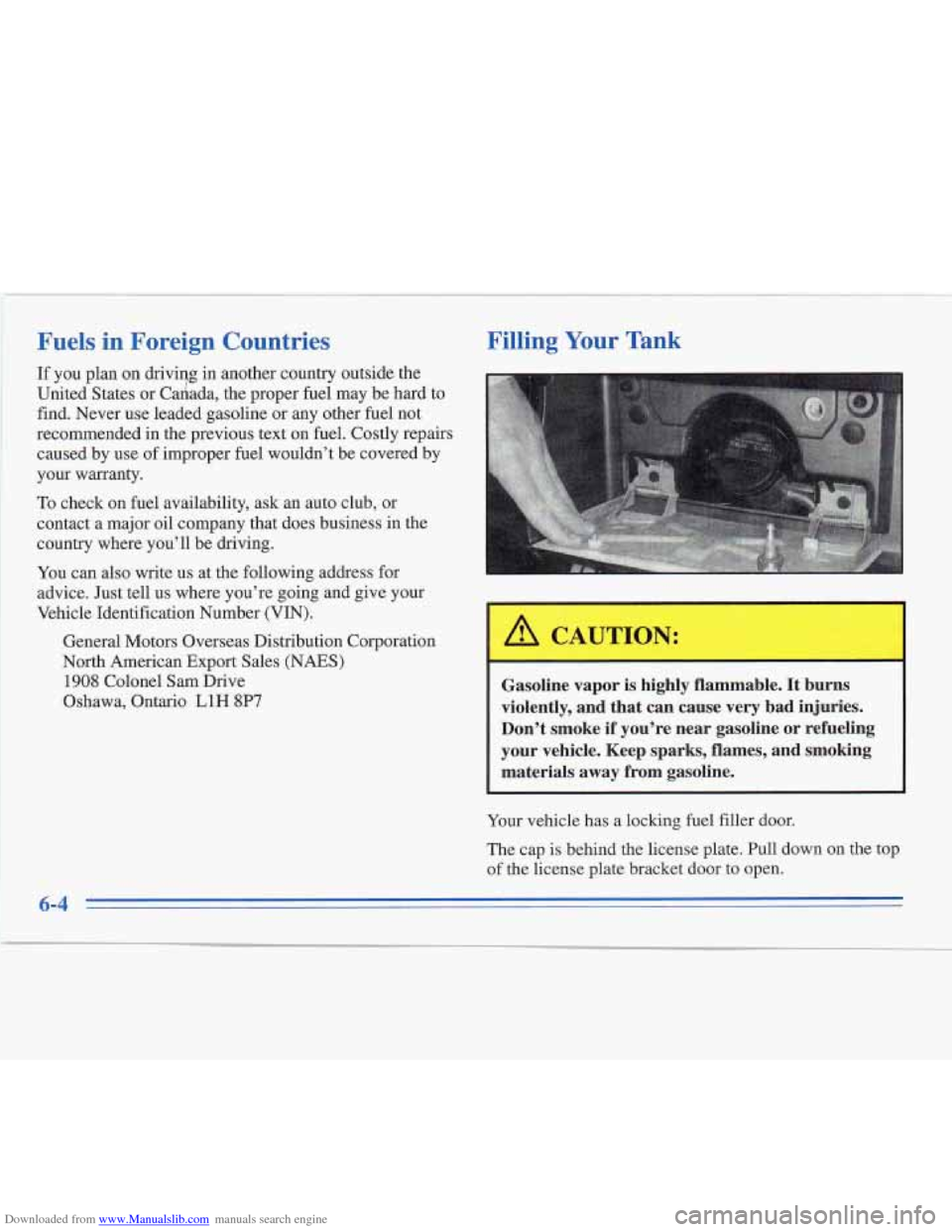
Downloaded from www.Manualslib.com manuals search engine Fuels in Foreign Countries
If you plan on dnviqg in another country outside the
United States or Canada, the proper fuel may be hard to
find. Never use leaded gasoline or any other fuel not
recommended in the previous text on fuel. Costly repairs
caused by use of improper fuel wouldn’t be covered by
your warranty.
To check on fuel availability, ask an auto club, or
contact a major oil company that does business in the
country where you’ll be driving.
You can also write us at the following address for
advice. Just tell
us where you’re going and give your
Vehicle Identification Number (VIN).
General Motors Overseas Distribution Corporation
North American Export Sales (NAES)
1908 Colonel Sam Drive
Oshawa, Ontario
L1H 8P7
Filling Your Tank
Gasoline vapor is highly flammable. It burns
violently, and that can cause very bad injuries.
Don’t smoke if you’re near gasoline or refueling
your vehicle. Keep sparks, flames, and smoking
materials away from gasoline.
Your vehicle has a locking fuel filler door.
The cap is behind the license plate. Pull down on the top
of the license plate bracket door
to open.
6-4
Page 223 of 306
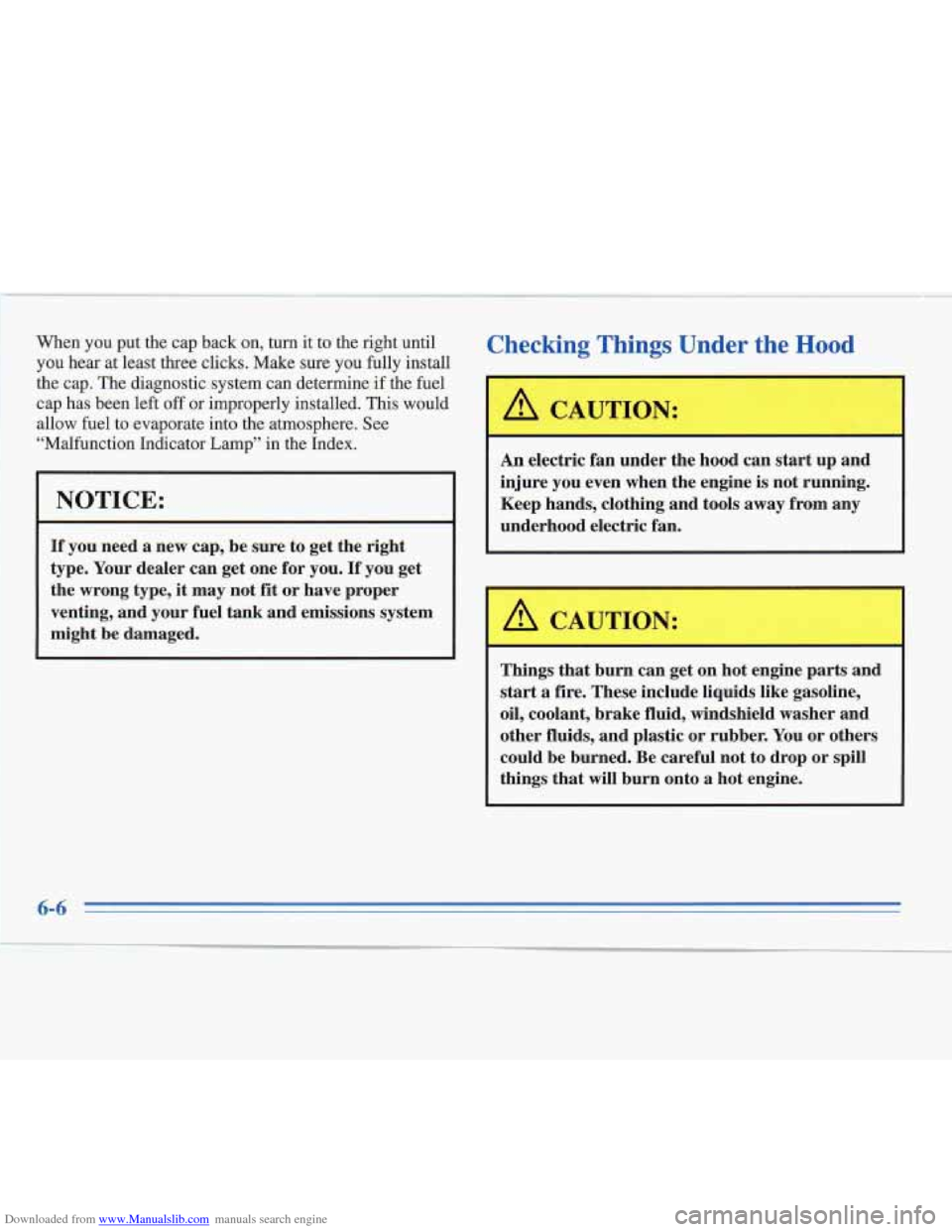
Downloaded from www.Manualslib.com manuals search engine When you put the cap back on, turn it to the right until
you hear at least three clicks. Make sure you fully install
the cap.
The diagnostic system can determine if the fuel
cap has been left off or improperly installed. This would
allow fuel to evaporate into the atmosphere. See
“Malfunction Indicator Lamp” in the Index.
NOTICE:
If you need a new cap, be sure to get the right
type. Your dealer can get one for you.
If you get
the wrong type,
it may not fit or have proper
venting, and your fuel tank and emissions system
might be damaged.
Checking Things Under the Hood
A CkmON’:
An electric fan under the hood can start up and
injure you even when the engine
is not running.
Keep hands, clothing and tools away from any
underhood electric fan.
Things that burn can get on hot engine parts and
start a fire. These include liquids like gasoline,
oil, coolant, brake fluid, windshield washer and
other fluids, and plastic or rubber. You or others
could be burned. Be careful not to drop or spill
things that will burn onto a hot engine.
6-6
Page 233 of 306
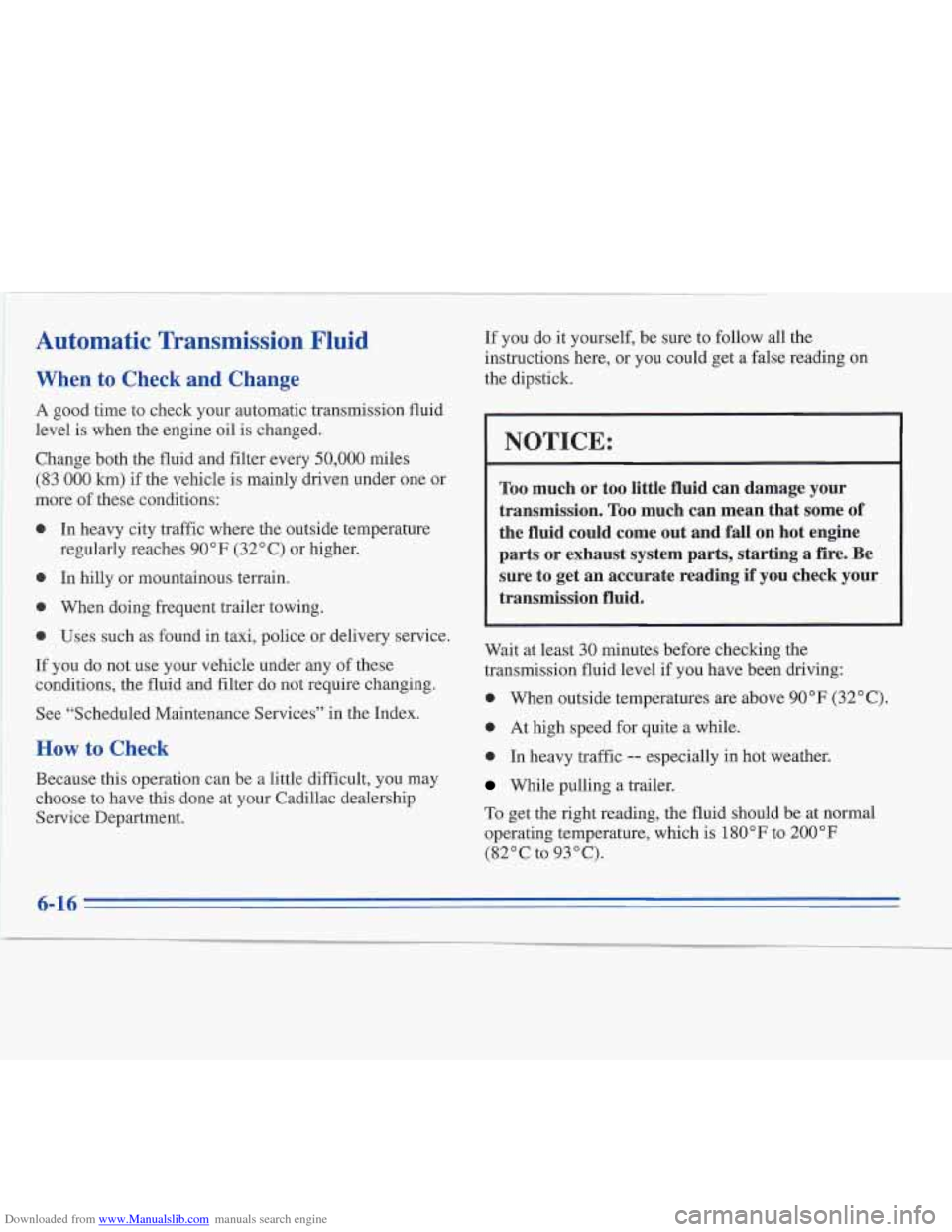
Downloaded from www.Manualslib.com manuals search engine ~~
~ Automatic Transmission -Fluid
When to Check and Change
A good time to check your automatic transmission fluid
level is when the engine oil is changed.
Change both the fluid and filter every
50,000 miles
(83
000 km) if the vehicle is mainly driven under one or
more of these conditions:
0 In heavy city traffic where the outside temperature
0 In hilly or mountainous terrain.
0 When doing frequent trailer towing.
0 Uses such as found in taxi, police or delivery service.
If you do not use your vehicle under any of these
conditions, the fluid and filter do not require changing.
See "Scheduled Maintenance Services" in the Index.
regularly reaches
90°F (32"
C) or higher.
How to Check
Because this operation can be a little difficult, you may
choose to have this done at your Cadillac dealership Service Department.
If you do it yourself, be sure to follow all the
instructions here, or you could get a false reading on
the dipstick.
NOTICE:
Too much or too little fluid can damage your
transmission.
Too much can mean that some of
the fluid could come out and fall
on hot engine
parts or exhaust system parts, starting a fire. Be
sure to get an accurate reading if you check your
transmission fluid.
Wait at least 30 minutes before checking the
transmission fluid level if you have been driving:
0 When outside temperatures are above 90°F (32" C).
0 At high speed for quite a while.
0 In heavy traffic -- especially in hot weather.
While pulling a trailer.
To get the right reading, the fluid should be at normal
operating temperature, which is
180 OF to 200 OF
(82°C to 93°C).
6-16
Page 238 of 306
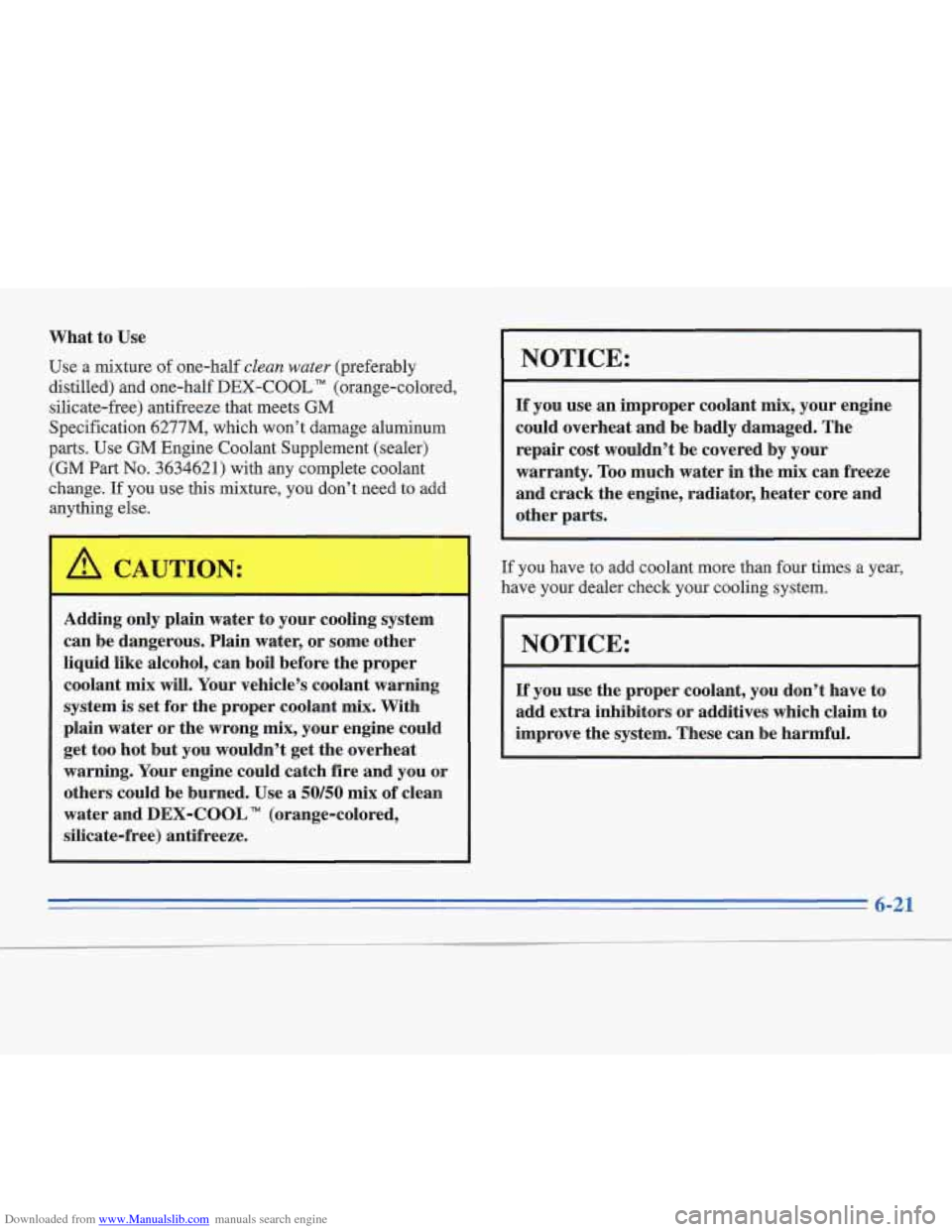
Downloaded from www.Manualslib.com manuals search engine What to Use
Use a mixture of one-half clean water (preferably
distilled) and one-half DEX-COOL
TM (orange-colored,
silicate-free) antifreeze that meets GM
Specification 6277M, which won’t damage aluminum
parts. Use GM Engine Coolant Supplement (sealer)
(GM
Part No. 3634621) with any complete coolant
change.
If you use this mixture, you don’t need to add
anything else.
I-
Adding only plain water to your cooling system
can be dangerous. Plain water, or some other
liquid like alcohol, can boil before the proper
coolant mix will. Your vehicle’s coolant warning
system is set for the proper coolant mix. With
plain water or the wrong
mix, your engine could
get too hot but you wouldn’t get the overheat
warning. Your engine could catch fire and you or
others could be burned. Use
a 50/50 mix of clean
water and
DEX-COOL TM (orange-colored,
silicate-free) antifreeze.
NOTICE:
If you use an improper coolant mix, your engine
could overheat and be badly damaged. The
repair cost wouldn’t be covered by your
warranty. Too much water in the
mix can freeze
and crack the engine, radiator, heater core and
other parts.
If you have to add coolant more than four times a year,
have your dealer check your cooling system.
1
NOTICE:
If you use the proper coolant, you don’t have to
add extra inhibitors or additives which claim to
improve the system. These can be harmful.
Page 297 of 306
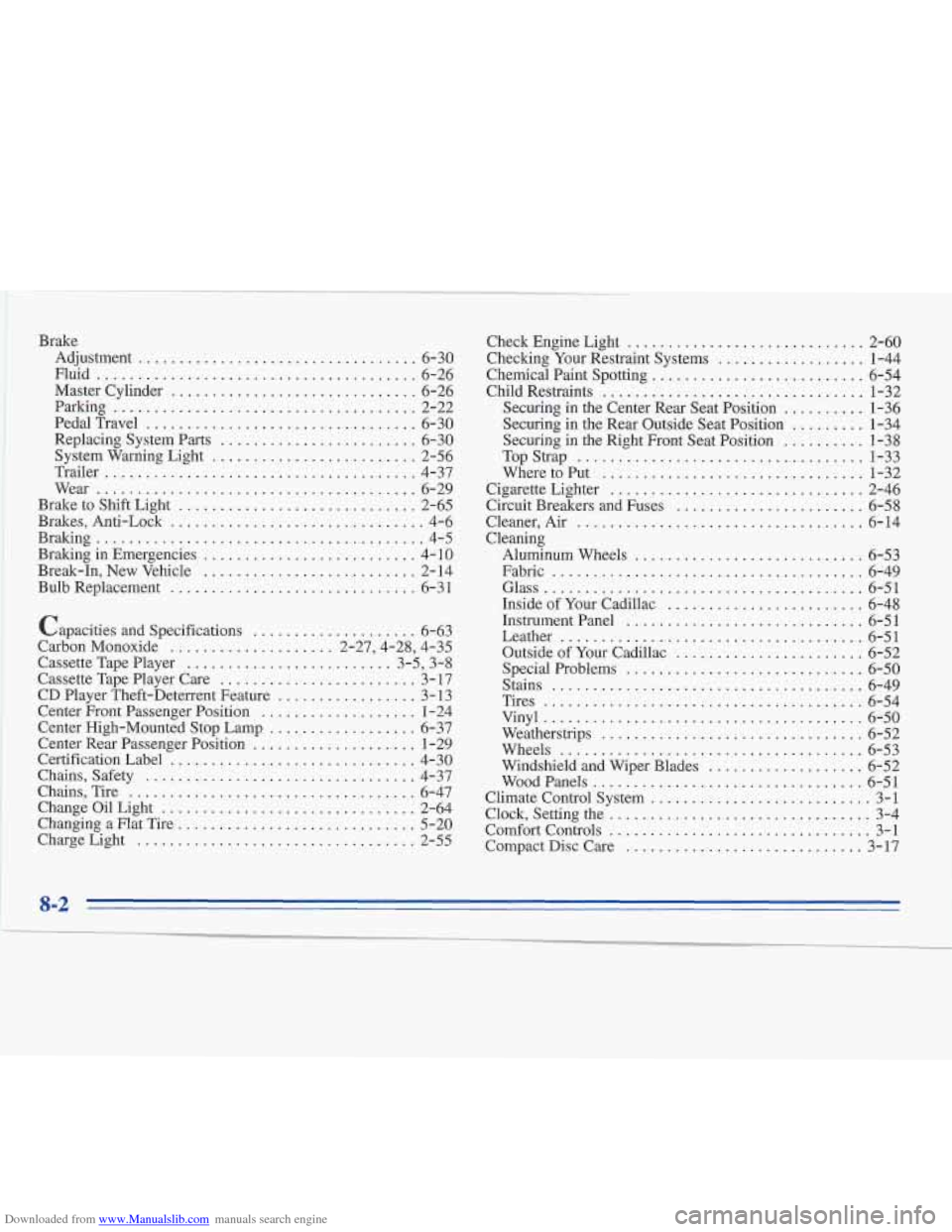
Downloaded from www.Manualslib.com manuals search engine Brake Adjustment
.................................. 6-30
Fluid
....................................... 6-26
Master Cylinder
.............................. 6-26
Parking
..................................... 2-22
PedalTravel
................................. 6-30
Replacing System Parts
........................ 6-30
System Warning Light
......................... 2-56
Trailer
...................................... 4-37
Wear
....................................... 6-29
Brake
to Shift Light ............................. 2-65
Brakes, Anti-Lock
............................... 4-6
Braking
........................................ 4-5
Braking
in Emergencies .......................... 4- 10
Break-In, New Vehicle
.......................... 2-14
Bulb Replacement
.............................. 6-3 1
Capacities and Specifications
.................... 6-63
Carbon Monoxide
.................... 2.27.4.28. 4.35
Cassette Tape Player
......................... 3.5. 3.8
Cassette Tape Player Care
........................ 3-17
CD Player Theft-Deterrent Feature
................. 3- 13
Center Front Passenger Position
................... 1-24
Center High-Mounted Stop Lamp
.................. 6-37
Center Rear Passenger Position
.................... 1-29
Certification Label
.............................. 4-30
Chains. Safety
................................. 4-37
Chains. Tire
................................... 6-47
ChangeOilLight
............................... 2-64
Changing a Flat Tire
............................. 5-20
ChargeLight
.................................. 2-55 Check
Engine Light
............................. 2-60
Checking Your Restraint Systems
.................. 1-44
Chemical Paint Spotting
.......................... 6-54
Child Restraints
................................ 1-32
Securing in the Center Rear Seat Position
.......... 1-36
Securing in the Rear Outside Seat Position
......... 1-34
Securing in the Right Front Seat Position
.......... 1-38
TopStrap
................................... 1-33
Wheretoput
................................ 1-32
Cigarette Lighter
............................... 2-46
Circuit Breakers and Fuses
....................... 6-58
Cleaner, Air
................................... 6-14
Cleaning Aluminum Wheels
............................ 6-53
Fabric
...................................... 6-49
Glass
....................................... 6-51
Inside of Your Cadillac
........................ 6-48
Instrument Panel
............................. 6-51
Leather
..................................... 6-51
Outside of Your Cadillac ....................... 6-52
Stains
...................................... 6-49
Tires
....................................... 6-54
Vinyl
....................................... 6-50
Weatherstrips
................................ 6-52
Wheels
..................................... 6-53
Windshield and Wiper Blades
................... 6-52
WoodPanels
................................. 6-51
Climate Control System
........................... 3-1
Clock. Setting the ................................ 3-4
Comfort Controls
................................ 3-1
Compact Disc Care
............................. 3-17
Special Problems
............................. 6-50